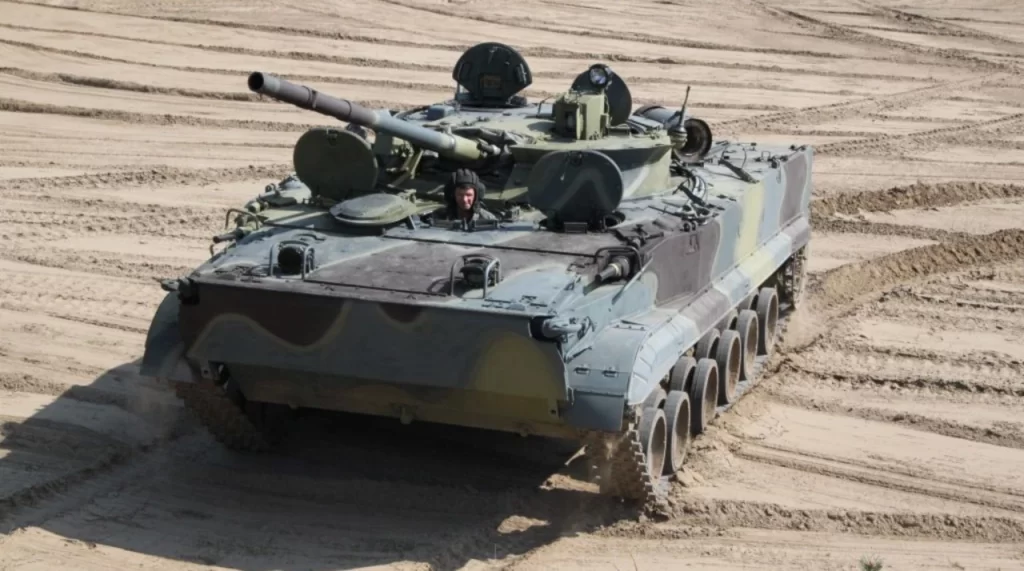The Russian troops began 2024 on a positive note, receiving their first batch of BMP-3 infantry fighting vehicles. “Kurganmashzavod” is the business that manufactures this highly sought-after armoured vehicle for the Russian Army.
The vehicles were brought to the military base by rail, marking Kurganmashzavod’s first dispatch of BMP-3 infantry fighting vehicles this year. Although the number of vehicles is unknown, Rostec’s press department said deliveries this year were one and a half times more than in the same period last year.
Notably, each BMP-3 issued to the military comes equipped with anti-cumulative grids and armoured screens. This infantry fighting vehicle has proven effective in combat operations in the Northern Military District, giving it a reputation as the Russian Army’s advanced infantry fighting vehicle, alongside the BMP-2 equipped with the Berezhok combat module.
The BMP-3 is a Soviet and Russian infantry fighting vehicle that has superseded the BMP-1 and BMP-2. The Kurganmashzavod firm developed it, and it first saw service with the Soviet Army in 1987.
The BMP-3 is recognised for its formidable weaponry and rugged armour. A 500-horsepower diesel engine powers it and can attain a top speed of 70 km/h on land and 10 km/h in water. The BMP-3 has a combat weight of 18.7 tonnes and can carry up to 7 infantry personnel plus a 3-member crew.
The BMP-3 has an outstanding operational range of up to 600 km without refuelling, making it ideal for long-distance missions. Furthermore, it is amphibious, meaning it can overcome water obstacles without needing bridges or ferries.
The BMP-3’s weaponry is significant. This vehicle is outfitted with a 100mm semi-automatic rifled gun/missile system 2A70, which can fire both conventional shells and Bastion anti-tank guided missiles. The BMP-3 also carries a 30mm automatic gun 2A72 and three 7.62mm PKT machine guns. It is also equipped to deploy anti-aircraft missiles, demonstrating its versatility as a combat vehicle.
Furthermore, the BMP-3 is outfitted with modern fire control systems and night vision, enabling accurate shooting in any weather, day or night. The vehicle’s strong armour is designed to withstand strikes from 30mm shells and provides reliable protection against nuclear, biological, and chemical threats.

The BMP-3 is used in military operations to transport infantry soldiers to the battlefield while providing armoured protection. Furthermore, the BMP-3 is designed to provide fire support to dismounted forces and can engage both ground and aerial targets.
One of the BMP-3’s primary advantages is its amphibious capability, which allows it to swim in water and cross water bodies while conducting operations in diverse terrain types.
In summary, the BMP-3 serves several functions in military operations, including troop mobility, direct fire support, and the ability to operate in various terrain situations. Its adaptability and broad range of capabilities make it an invaluable tool in modern warfare for the Russians.
The CEO of Rostec, Sergey Chemezov, dropped some surprises on January 7. Russia seems to be putting a lot of effort into testing a prototype of an unmanned war robot in Ukraine. The robot in question is a remote-controlled, upgraded version of the BMP-3 infantry fighting vehicle.
The “Sinitza” module allows for remote control. The module may convert a manually controlled BMP-3 into a fully autonomous robotic machine. What’s more impressive is that the module may be controlled by a unique control station that closely resembles a tablet. “Sinitza” autonomous combat module comes alongside its integrated panoramic viewfinder. This all-encompassing set comprises a formidable 7.62mm machine gun, 30mm auxiliary artillery, and 100mm primary artillery.
Information about the BMP-3 prototype, a tracked chassis unmanned combat vehicle, was made public last year. It is distinguished by its one-of-a-kind V-shaped engine, YTD-19, which generates 500 horsepower. Manufacturers lauded its capacity to traverse ditches, enabling it to span spaces as wide as 2.5 metres.
Early estimates by Rostec placed the BMP-3’s top speed at approximately 70 kilometres per hour. Additionally, it has a range of 600 kilometres before requiring refuelling. It comes built with a 700-litre tank. Official confirmation of these technical specifications is pending, nonetheless.
Omnidirectional cameras contribute to the BMP-3’s simplicity of remote operation. By integrating artificial intelligence and using data from additional sensors, it can generate and show 3D landscapes. A compact drone is integrated into the BMP-3 for mine clearance and observation, enhancing its functional capabilities.
M2 Bradley (the closest equivalent from the United States), Warrior (United Kingdom), Marder (Germany, an older design but still in service), CV90 (Sweden, a modern family of Swedish IFVs with 30-40mm cannons), Dardo (Italy), Puma (Germany), and ASCOD (Spain) are BMP-3’s western competitors.
